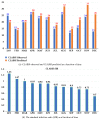WMSS: A Web-Based Multitiered Surveillance System for Predicting CLABSI
- PMID: 30069472
- PMCID: PMC6057346
- DOI: 10.1155/2018/5419313
WMSS: A Web-Based Multitiered Surveillance System for Predicting CLABSI
Abstract
Central-line-associated bloodstream infection (CLABSI) rates are a key quality metric for comparing hospital quality and safety. Manual surveillance systems for CLABSIs are time-consuming and often limited to intensive care units (ICUs). A computer-automated method of CLABSI detection can improve the validity of surveillance. A new web-based, multitiered surveillance system for predicting and reducing CLABSI is proposed. The system has the capability to collect patient-related data from hospital databases and hence predict the patient infection automatically based on knowledge discovery rules and CLABSI decision standard algorithms. In addition, the system has a built-in simulator for generating patients' data records, when needed, offering the capability to train nurses and medical staff for enhancing their qualifications. Applying the proposed system, both CLABSI rates and patient treatment costs can be reduced significantly. The system has many benefits, among which there is the following: it is a web-based system that can collect real patients' data from many IT resources using iPhone, iPad, laptops, Internet, scanners, and hospital databases. These facilities help to collect patients' actual data quickly and safely in electronic format and hence predict CLABSI efficiently. Automation of the patients' data diagnosis process helps in reducing CLABSI detection times. The system is multimedia-based; it uses text, colors, and graphics to enhance patient healthcare report generation and charts. It helps healthcare decision makers to review and approve policies and surveillance plans to reduce and prevent CLABSI.
Figures










References
-
- Custodio T. H., Steele W. R. Hospital Acquired Infections. 2016 [cited 2017 March 15]; 1-7, http://emedicine.medscape.com/article/967022-overview.
-
- The Centers for Disease Control and Prevention (CDC) 19 April 2017 [cited 2017 April 20]; 1–10, https://en.wikipedia.org/wiki/Centers_for_Disease_Control_and_Prevention.
-
- National Healthcare Safety Network (NHSN) Overview - CDC. Jan 2017 [cited 2017 April 20]; 1–4, https://www.cdc.gov/nhsn/pdfs/pscmanual/1psc_overviewcurrent.pdf.
-
- Central Line-associated Bloodstream Infection (CLABSI) March 2016 [cited 2017 April 20], https://www.cdc.gov/hai/bsi/bsi.html.
MeSH terms
LinkOut - more resources
Full Text Sources
Other Literature Sources

